Tässä artikkelissa käsittelemme koneistusprosesseja (kääntyminen, jyrsintä, viimeistely), työkaluja, alumiinin ja alumiiniseosten CNC-työstöön liittyvät parametrit ja haasteet. Analysoimme myös alumiinin ja CNC-työstössä yleisimmin käytettyjen metalliseosten ominaisuuksia, sekä niiden käyttöalueet eri teollisuuden aloilla.
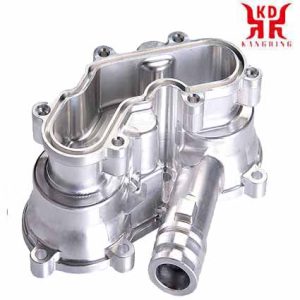
Rapid prototyping of aluminum alloy parts
If you are interested in CNC machining aluminum, you can request a quote for your parts here.
Aluminum is one of the most widely used materials today. Itse asiassa, aluminum is only surpassed by steel in terms of frequency of use in CNC machining. This is mainly due to the excellent machinability of aluminum.
In its pure form, the chemical element aluminum is soft, malleable, non-magnetic and has a silvery-white appearance. kuitenkin, the element aluminum is not only used in its pure form. Aluminum is normally used in conjunction with various elements such as manganese, copper and magnesium to produce hundreds of aluminum alloys with various, significantly improved properties. The most common aluminum alloys and their respective designations in the various standards can be found here.
Kuva 1: Pure aluminum
Benefits of using aluminum for CNC machined components
Although there are many different aluminum alloys with different properties, all aluminum alloys have the same essential properties.
Koneistettavuus
Aluminum can be shaped and machined using a variety of different methods. It can be cut quickly and easily with the help of processing machines because it is soft and has high machinability. It is also cheaper than steel and requires less machining. These properties are of great benefit to the cutting machine operator and the customer. Lisäksi, aluminum is less deformed during machining due to its high machinability. This leads to higher accuracy, as CNC machines can achieve higher tolerances.
Strength to weight ratio
The density of aluminum is about a third of the density of steel. So aluminum is relatively light. Despite its low weight, aluminum is very strong. Tätä suuren lujuuden ja alhaisen painon yhdistelmää kuvaa lujuus-painosuhde. Sen korkea lujuus-painosuhde tekee alumiinista edullisen materiaalin komponenteille eri teollisuuden aloilla, kuten auto- ja ilmailuteollisuus.
Korroosionkestävyys
Alumiini kestää naarmuuntumista ja korroosiota tyypillisissä meri- ja ilmakehän olosuhteissa. Näitä ominaisuuksia voidaan parantaa anodisoimalla. Se pitäisi huomata, kuitenkin, että korroosionkestävyys vaihtelee alumiinityypin mukaan. kuitenkin, yleisimmillä CNC-työstyksessä käytetyillä alumiinityypeillä on suurin vastustuskyky.
Käyttäytyminen matalissa lämpötiloissa
Useimmat materiaalit menettävät osan hyödyllisistä ominaisuuksistaan alle nollan lämpötiloissa. Esimerkiksi, sekä hiiliteräs että kumi hauraavat alhaisissa lämpötiloissa. Verrattuna, alumiini pysyy pehmeänä, malleable and strong even at very low temperatures.
Electric conductivity
The electrical conductivity of pure aluminum at room temperature is 36.7 million Siemens per meter. Although aluminum alloys can have lower conductivities than pure aluminum, they are conductive enough to be used as electrical components. Toisaalta, aluminum is unsuitable if a high electrical conductivity of the manufactured component is undesirable.
Kierrätettävyys
Since CNC machining is a subtractive manufacturing process, a lot of chips and therefore a lot of material waste occur during machining. Aluminum is well suited for recycling, eli. relatively little energy, effort and costs are required to recycle aluminum. This also makes it an advantageous material in terms of avoiding waste of material. This also makes aluminum a more environmentally friendly material in CNC machining.
Anodisointi
The anodizing process is a surface finishing process that improves the wear resistance and corrosion resistance of a material. Aluminum is suitable for the anodizing process. This process also makes it easier to color the manufactured aluminum components.
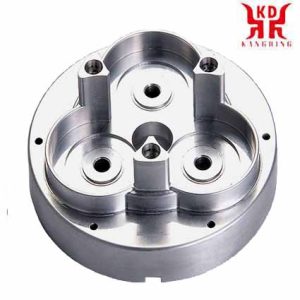
Alumiiniosien CNC-jyrsintä
Popular aluminum alloys for CNC machining
In our experience, the following 5 types of aluminum are most commonly used in CNC machining.
EN AW 2007
Alternative names: 3.1645; EN 573-3; AlCu4PbMgMn.
This aluminum alloy contains copper as the main alloying element (4-5% kupari). It is a short-chip alloy that is light, durable, highly functional and has the same mechanical properties as AW 2030. It is also suitable for thread cutting, heat treatment and high speed machining. All these properties make EN AW 2007 laajalti käytetty materiaali komponenttien valmistuksessa, pultit, ruuvit, pähkinät, niitit ja kierretangot. kuitenkin, tämäntyyppisellä alumiinilla on huono hitsattavuus ja korroosionkestävyys; Siksi on suositeltavaa käyttää suojaavaa anodisointia komponentin valmistuksen jälkeen.
EN AW 5083
Alternative names: 3.3547; Metalliseos 5083; EN 573-3; US A95083; ASTM B209; AlMg4,5Mn0,7
AW 5083 tunnetaan erinomaisesta suorituskyvystään ankarissa olosuhteissa. Se sisältää magnesiumia ja jäämiä kromista ja mangaanista. Tällä lajikkeella on erittäin korkea korroosionkestävyys kemiallisissa ja meriympäristöissä. AW 5080 sillä on suurin lujuus kaikista ei-lämpökäsiteltävissä olevista seoksista; ominaisuus, jonka se saa myös hitsauksen jälkeen. Vaikka tätä seosta ei tule käyttää sovelluksissa, joissa lämpötila on yli 65 °C, sillä on erinomainen suorituskyky matalissa lämpötiloissa.
Sen hyödyllisten ominaisuuksien ansiosta, AW 5080 is used for a wide variety of applications including cryogenic systems, marine applications, pressure systems, chemical applications, welded structures and vehicle bodies.
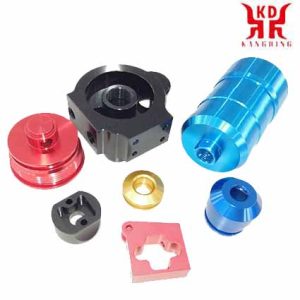
Surface finishing of aluminum alloy parts
EN AW 5754
Alternative names: 3.3535; Metalliseos 5754; EN 573-3; U21NS A95754; ASTM B 209; Al-Mg3.
As an aluminum-magnesium kneading material with the highest percentage of aluminum, AW 5754 can be rolled, forged and extruded. It is not heat treatable and can be cold worked to increase strength at the expense of formability. Lisäksi, this alloy is excellent in corrosion resistance and has high strength. With these properties, it is not surprising that AW 5754 is one of the most widely used types of aluminum in CNC machining. It is commonly used in welded structures, floors, fishing gear, vehicle bodies, rivets, and in food processing.
EN AW 6061
Alternative names: 3.3206; ISO 6361; UNS A96060; ASTM B 221; AlMgSi0.5
This is a wrought alloy containing magnesium and silicon. It is heat treatable and has average strength, good weldability and good formability. Lisäksi, it has a very high corrosion resistance; a property that can be improved by anodizing. EN AW 6060 is widely used in construction, food processing, medical technology and automotive technology.
EN AW 7075
Alternative names: 3.4365; UNS A96082; H30; Al-Zn6MgCu.
The main alloying element of this type of aluminum is zinc. Although EN AW 7075 has average machinability, poor cold forming properties and is unsuitable for welding or brazing, it has a high strength-to-weight ratio, excellent resistance to atmospheric and marine environments, and strength comparable to some steel alloys. This alloy is used in a very wide range of applications – from hang gliders, bicycle frames, climbing equipment and weapons to the construction of manufacturing tools.
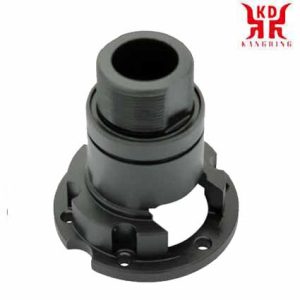
Turned parts of aluminum alloy
CNC machining process for aluminum
Aluminum can be machined using many of the CNC processes available today. We have listed some of these procedures:
Kääntäminen
In CNC machining processes, the workpiece rotates while the single-point cutting tool remains stationary along its axis. Depending on the machine used, either the workpiece or the cutting tool performs a feed movement in order to remove the material.
Find out more about our CNC turning services.
Jyrsintä
Milling processes are the most frequently used methods when machining aluminum components. These methods consist of rotating a multipoint cutting tool along its axis while the workpiece remains stationary along its own axis. The cutting action and subsequent material removal is achieved by a feed movement of the workpiece or the cutting tool, or a combination of both. This movement can take place along several axes.
Find out more about our CNC milling services.
Pocket milling
Pocket milling, also known as pocketing, is a CNC milling method in which a hollow pocket is milled into a component.
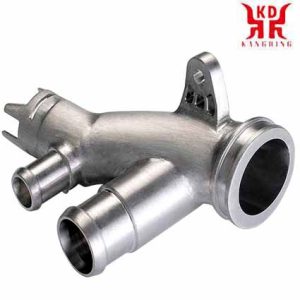
CNC machining of aluminum alloy parts
Face turning and face milling
In machine processing, facing / milling is the creation of a flat cross-sectional area on the surface of a workpiece by turning / jyrsintä.
Poraus
Drilling is the process of creating a hole in a workpiece. In this process, a multi-point rotating cutting tool of a certain size moves in a straight line, perpendicular to the surface to be machined, effectively creating a hole.
Tools for aluminum processing
Many different factors play a role when selecting tools for CNC machining.
Tool design
Työkalun erilaiset geometriset näkökohdat lisäävät alumiinin työstön tehokkuutta. Yksi niistä on leikkuureunojen lukumäärä. Jotta vältytään vaikeuksilta lastujen poistamisessa suurilla nopeuksilla, alumiinin CNC-työstön leikkaustyökaluissa tulee olla 2-3 leikkuureunat. Suurempi leikkaussärmien määrä johtaa pienempiin lastuihin. Tämä aiheuttaa alumiiniseosten suuret lastut juuttumaan kiinni. Kun leikkausvoimat ovat alhaiset ja lastunpoisto on prosessin tärkein huolenaihe, tulee käyttää kahta leikkuureunaa. Kolmea leikkuuterää voidaan käyttää täydelliseen tasapainoon lastunpoiston ja työkalun lujuuden välillä.
Helix-kulma
Kierrekulma on työkalun keskilinjan ja leikkuureunaa pitkin kulkevan suoran tangentin välinen kulma. Suuri kierrekulma poistaa lastut nopeasti, tämä lisää myös kitkaa ja lämmön muodostumista koneistuksen aikana. Tämä voi aiheuttaa lastujen hitsaamisen työkalun pintaan alumiinin nopean CNC-työstön aikana. Pienempi heliksikulma johtaa vähemmän lämmöntuotantoon, mutta se ei ehkä pysty poistamaan lastuja tehokkaasti. Kun työstetään alumiinia, viistokulma 35 ° tai 40 ° sopii kovaan käyttöön, kun taas kulma 45 ° sopii viimeistelytöihin.
Poistokulma
Vapaakulma on toinen tärkeä tekijä työkalun moitteettoman toiminnan kannalta. Liian suuri kulma saa työkalun kaivautumaan komponenttiin ja helisemään edestakaisin. Toisaalta, liian pienet kulmat voivat johtaa suureen kitkaan työkalun ja työkappaleen välillä. Välikulmat 6 ° ja 10 ° soveltuvat erityisen hyvin alumiinin CNC-työstöön.
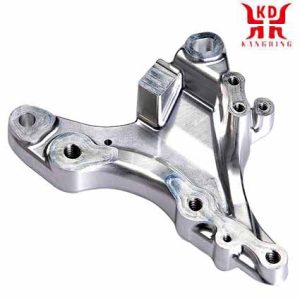
Aluminum die casting
Tool material
Tungsten carbide is the preferred material for cutting tools used in CNC aluminum machining. Since aluminum is very soft and easy to cut, the decisive factor in a cutting tool for aluminum is not the hardness, but the ability to obtain a razor-sharp edge. This ability is present in cemented carbide tools and depends on two factors, the cemented carbide grain size and the proportion of binder. While a larger grain size results in a harder material, a smaller grain size guarantees a tougher, more impact-resistant material that is exactly the property we need. Smaller grains require cobalt to achieve the fine grain structure and strength of the material.
kuitenkin, cobalt reacts with aluminum at high temperatures and forms a built-up edge made of aluminum on the tool surface. The key is to use a cemented carbide tool with the right amount of cobalt (2-20%) to minimize this reaction while maintaining the required strength. Tungsten carbide tools are generally better suited to withstanding the high speeds of CNC aluminum machining than steel tools. In addition to the tool material, the coating of the tool is an important factor in the cutting efficiency of the tool.
ZrN (zirconium nitride), TiB2 (titanium boride) and diamond-like coatings are some of the suitable tool coatings for CNC machining of aluminum.
Feeds and speeds
The cutting speed is the speed at which the cutting tool rotates. Since aluminum can withstand very high cutting speeds, the cutting speed for aluminum alloys depends on the application limits of the machine used. As with CNC aluminum machining, the speed should be as high as possible, as this reduces the risk of built-up edges, saves time, minimizes the temperature rise in the component, improves chip breaking and improves the surface finish. The exact working speed depends on the aluminum alloy and the tool diameter.
The feed is the distance that the workpiece or tool is moved per revolution of the tool. The feed rate used depends on the desired surface finish, strength and rigidity of the workpiece. Rough cuts require a feed of 0.15 to 2.03 mm / rev, while finishing operations require a feed of 0.05 to 0.15 mm / rev.
Cooling lubricant
Despite its good machinability, aluminum should never be cut dry as this promotes the formation of built-up edges. Suitable cooling lubricants for aluminum CNC machining are soluble oil emulsions and mineral oils. Avoid cooling lubricants that contain chlorine or active sulfur, as these elements pickle aluminum. You can find out more about cooling lubricants here.
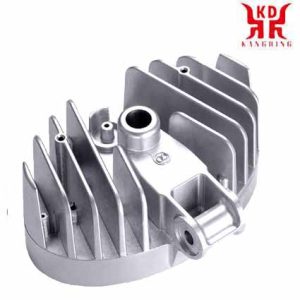
CNC machining aluminum alloy cavity
Post-processing processes
After machining an aluminum part, there are certain processes that can be carried out to improve the physical, mechanical and aesthetic properties of the part. The most common methods are listed below.
Pearl blasting – compressed air blasting with solid abrasive
Bead blasting is a finishing process for aesthetic purposes. In this process, the manufactured component is blasted with a strong jet of compressed air and tiny glass beads, which effectively removes the material and ensures a smooth surface. It gives aluminum a satin or matt surface. The most important process parameters for bead blasting are the size of the glass beads and the strength of the air pressure used. Use this procedure only when the dimensional tolerances of the part are not critical.
Other finishing processes are polishing and painting.
Coating
In this process, the aluminum workpiece is coated with another material, for example zinc, nickel or chromium. This is done to improve the functionality of the component and can be achieved through electrochemical processes.
Anodisointi
The anodizing process is an electrochemical process in which the aluminum workpiece is placed in a solution of sulfuric acid. An electrical voltage is then applied between the anode and cathode. This process converts the exposed surfaces of the workpiece into an electrically non-reactive aluminum oxide coating. Pinnoitteen tiheys ja paksuus riippuvat liuoksen koostumuksesta, anodisointiprosessin kesto ja käytetty sähkövirta. Anodisointia voidaan käyttää myös komponentin värjäämiseen.

Alumiiniprofiili
Jauhemaalaus
Jauhemaalausprosessissa, komponentti päällystetään värillisellä polymeerijauheella sähköstaattisen ruiskupistoolin avulla. Osa kovetetaan sitten lämpötilassa 200 °C. Jauhemaalaus parantaa lujuutta ja kulutuskestävyyttä, korroosiota ja iskuja.
Lämpökäsittely
Lämpökäsitellyistä alumiiniseoksista valmistetut komponentit voidaan lämpökäsitellä niiden mekaanisten ominaisuuksien parantamiseksi.
CNC-valmistettujen alumiinikomponenttien sovellukset teollisuudessa
Kuten yllä mainittu, alumiiniseoksilla on useita edullisia ominaisuuksia. Tästä syystä CNC-valmisteiset alumiinikomponentit ovat välttämättömiä monilla teollisuudenaloilla, mukaan lukien:
Ilmailu: Korkean lujuus-painosuhteen ansiosta, monet lentokoneiden varusteet on valmistettu alumiinista.
Autoteollisuus: samanlainen kuin ilmailuteollisuudessa, monet komponentit, kuten akselit ja muut komponentit, on valmistettu alumiinista.
Elektroniikka: Korkean sähkönjohtavuutensa ansiosta, CNC-valmisteisia alumiinikomponentteja käytetään usein sähkölaitteiden sähkökomponentteina.
Elintarvike- ja lääketeollisuus: Koska alumiini ei reagoi useimpien orgaanisten aineiden kanssa, alumiinikomponenteilla on tärkeä rooli elintarvike- ja lääketeollisuudessa.
Urheilu: Alumiinia käytetään laajalti urheiluvälineiden, kuten pesäpallomailojen ja pillien valmistukseen.
Matalan lämpötilan tekniikka: Due to the ability of aluminum to maintain its mechanical properties even at temperatures below zero, aluminum components are often used in low-temperature applications.
 English
English العربية
العربية 中文(漢字)
中文(漢字) Čeština
Čeština Dansk
Dansk Nederlands
Nederlands Suomi
Suomi Français
Français Deutsch
Deutsch Italiano
Italiano 日本語
日本語 ಕನ್ನಡ
ಕನ್ನಡ 한국어
한국어 Português
Português Русский
Русский Slovenčina
Slovenčina Español
Español Svenska
Svenska Türkçe
Türkçe

